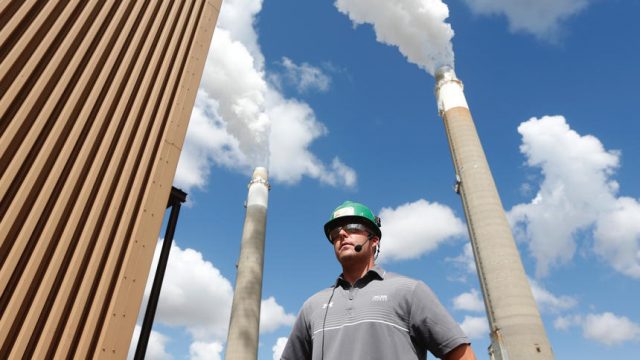Mike Jones: North Dakota Leads in Clean Coal Technology

Ethan Vaagene stands between the powerplant's stacks at Great River Energy's Coal Creek Station on Wednesday, August 19, 2015, in Underwood, N.D. (Logan Werlinger/Grand Forks Herald)
As the United States and countries throughout the world seek ways to reduce man-made CO2 emissions, the state of North Dakota will be a leader in finding a solution for low-rank coals such as lignite while continuing to supply affordable and reliable electricity.
North Dakota has several unique characteristics:
- A state-industry R&D partnership with a 30-year track record of success. These funds are distributed based on evaluations and recommendations through the Lignite Research Council, a governor-appointed advisory council made up of representatives of key stakeholders in the lignite industry;
- Home to the Energy & Environmental Research Center (EERC), known internationally as a top lignite research and development organization;
- Existing CO2 infrastructure including a pipeline and compressor facilities from the coal fields through the oil fields of western North Dakota. The lignite industry has been providing CO2 for enhanced oil recovery (EOR) since 2000.
- The lignite resource in the state is enormous. Only Australia has a larger known lignite reserve. At current production levels, North Dakota reserves would last more than 800 years.
- A history of outstanding lignite mine reclamation and meeting all federal ambient air quality standards.
- An energy-rich, business-friendly state that promotes all sources of energy including coal, oil, natural gas, hydro power, wind, ethanol and other renewables.
Since its beginning in 1987, the Lignite R&D program has provided $63.5 million in state funds for more than 200 lignite R&D projects. The state money is derived from taxes paid to the state by the lignite industry. The total investment to date for all projects is more than $650 million. So for every state dollar invested, more than nine dollars comes from other sources – including industry, research entities and the Department of Energy demonstrating the truly collaborative nature of the research.

The Lignite Energy Council is committed to finding a carbon solution for our industry and supporting a development pathway for the Allam Cycle – or other low carbon footprint technologies – benefiting both the North Dakota lignite industry and the oil and gas industry.
The Allam Cycle is a novel supercritical CO2 power cycle, which is projected to match or lower the current cost of electricity while also inherently capturing all CO2 and other air emissions. The cycle produces CO2 as a pipeline-quality byproduct, as opposed to conventional power plants, where CO2 is produced as an exhaust-gas mixed with other gases and emitted through a stack.
A preliminary technical and economic study was conducted by the Energy & Environmental Research Center showing that the owners of power plants using this technology could derive two revenue streams. One stream would be for the power and the other from the sale of CO2, which is valuable to enhance the oil production from partially depleted oil-bearing formations. This combination means that electricity produced from a new Allam Cycle plant could be competitive with electricity produced from conventional coal-based power plants.




